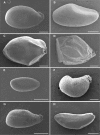A revision of infrageneric classification in Astelia Banks & Sol. ex R.Br. (Asteliaceae)
- PMID: 26312037
- PMCID: PMC4549886
- DOI: 10.3897/phytokeys.52.4768
A revision of infrageneric classification in Astelia Banks & Sol. ex R.Br. (Asteliaceae)
Erratum in
-
Corrigenda: A revision of infrageneric classification in Astelia Banks & Sol. ex R.Br. (Asteliaceae).PhytoKeys. 2015 Oct 9;(56):127-8. doi: 10.3897/phytokeys.56.6517. eCollection 2015. PhytoKeys. 2015. PMID: 26494977 Free PMC article.
Abstract
Systematic investigations and phylogenetic analyses have indicated that Astelia, as currently circumscribed, is paraphyletic, with Collospermum nested within it. Further, AsteliasubgenusAstelia is polyphyletic, and Astelia subgenera Asteliopsis and Tricella are paraphyletic, as currently circumscribed. Revision of the subgeneric classification of Astelia is warranted to ensure classification accurately reflects the evolutionary history of these taxa. Collospermum is relegated to synonymy within Astelia. Astelia is dioecious or polygamodioecious, with a superior ovary, anthers dorsi- or basifixed, pistillodes or pistils that have a single short or poorly defined style, a 3 lobed stigma, and fleshy uni- or trilocular fruit with funicular hairs that are poorly to well developed. AsteliasubgenusCollospermum (Skottsb.) Birch is described. A key to Astelia sections is provided. Asteliahastata Colenso, Asteliamontana Seem., and Asteliamicrosperma Colenso pro parte are resurrected and the new combination Asteliasamoense (Skottsb.) Birch, comb. nov. is made.
Keywords: Asparagales; Asteliaceae; Austral; Australia; New Zealand; Pacific; dioecy.
Figures

References
-
- Bayer C, Appel O, Rudall PJ. (1998) Asteliaceae. In: Kubitzki K, Huber H. (Eds) Flowering Plants, Monocotyledons: Lilianae (except Orchidaceae) Vol. 3 Springer-Verlag, Berlin, 141–145. doi: 10.1007/978-3-662-03533-7_17 - DOI
-
- Birch JL, Keeley SC, Morden CW. (2012) Molecular phylogeny and dating of Asteliaceae (Asparagales): Astelia s.l. evolution provides insight into the Oligocene history of New Zealand. Molecular Phylogenetics and Evolution 65: 102–115. doi: 10.1016/j.ympev.2012.05.031 - DOI - PubMed
-
- Brown R. (1810) Prodromus Florae Novae Hollandiae et Insulae van-Diemen. Hafner Publishing Co., New York.
-
- Carse H. (1926) Botanical notes with descriptions of new species. Transactions and Proceedings of the New Zealand Institute, Wellington: 57: 89–92.
-
- Colenso W. (1885) A description of a few new plants from our New Zealand forests. Transactions and Proceedings of the New Zealand Institute, Wellington 14: 329–341.
LinkOut - more resources
Full Text Sources
Other Literature Sources
Molecular Biology Databases
